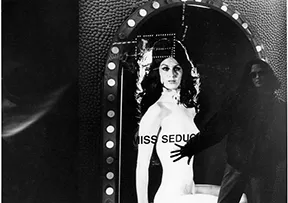Camera Erotica
Two History of Art grad students co-curate an exhibit at the Museum of Sex.
Bryn Mawr graduate students Emily Alesandrini and Emily Shoyer recently co-curated Self Power | Self Play, an exhibition of erotic portraiture by Linda Troeller, at The Museum of Sex in New York. The project featured 25 photographs from Bryn Mawr’s Special Collections accompanied by more than 40 additional images from Troeller’s studio and archive.
“Now in her 70s, the photographer continues to produce dynamic, irreverent portraits that assert the right for a woman to control the pleasures and potentials of her own body. The temporal breadth of the project demonstrates Troeller’s early and historically neglected commitment to challenging social taboos and exploring uninhibited sexual identity,” say the curators. “Troeller strategically utilizes her photographic practice to embolden female intimacy, pleasure, masturbation, and orgasm, using the camera as a tool for sensual empowerment. Her work insists and illustrates: we are all worthy of bodily liberation, autonomy, and pleasure.”
Both Shoyer and Alesandrini have several years of experience curating contemporary art, including contributions at the Ford Foundation, MoMA, The Studio Museum in Harlem, the Whitney Museum of American Art, and other institutions and galleries.
This is the first exhibit they have co-curated. “I feel phenomenally fortunate to have found a colleague, collaborator, and close friend in Emily Shoyer,” says Alesandrini. “And Bryn Mawr’s History of Art department is the ideal environment for this kind of creative approach to expanding the work explored in readings and seminar discussions beyond the classroom.”
Self Power / Self Play came about when Bryn Mawr Curator of Art and Artifacts Carrie Robbins shared a series of Troeller’s images in Bryn Mawr’s Special Collections with Alesandrini, who is currently serving as Special Collections curatorial fellow. Robbins expressed a desire to see the work on view as part of a larger conversation. The Museum of Sex (where Shoyer works as curator at large) provided a natural fit for this conversation as well as the opportunity to expand the audience and viewership.
The theme of bodily autonomy and the assertion of female pleasure took on additional potency with the Roe v. Wade reversal, say the curators.
“The Supreme Court decision, made mere months before the exhibition opening, further solidified the project’s mission of bodily liberation and feminist empowerment.”
Looking to the future, Alesandrini aims to continue her focus on curatorial work, especially in community-based collaboration. Shoyer plans to integrate her curatorial experience into the classroom, expanding upon her museum work to inform her pedagogy and mentorship of future scholars.
Emily Shoyer’s solo exhibition of feminist sculptor Portia Munson’s work is currently on view at The Museum
of Sex. Emily Alesandrini’s next project features women and non-binary artists of color exploring the intersections of place, gender, and class through food and consumption culture. It opens at The Elizabeth Foundation in midtown Manhattan in March 2023.
Published on: 02/13/2023
